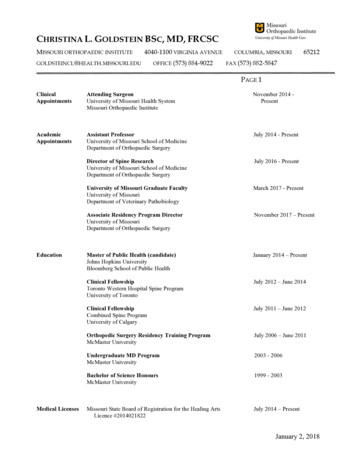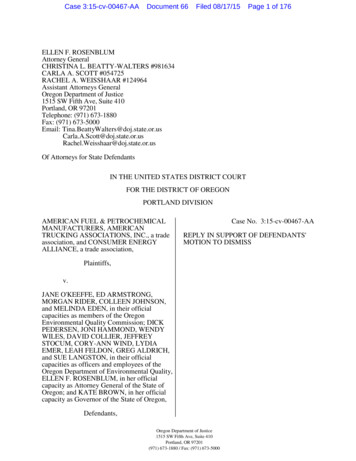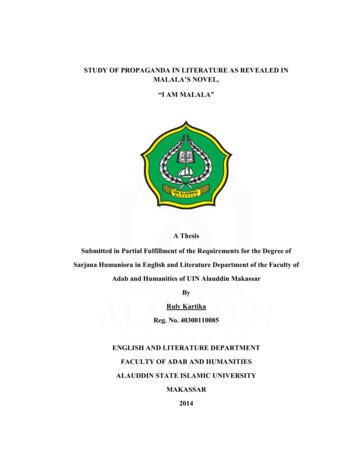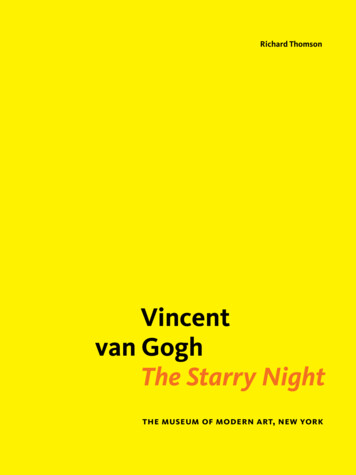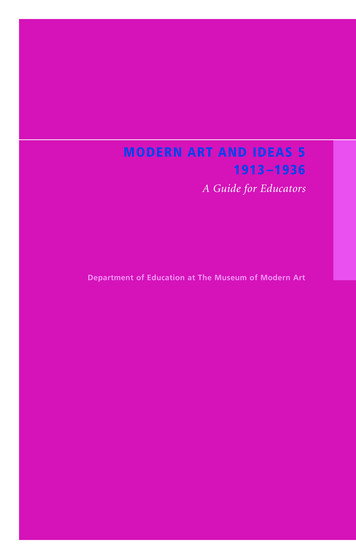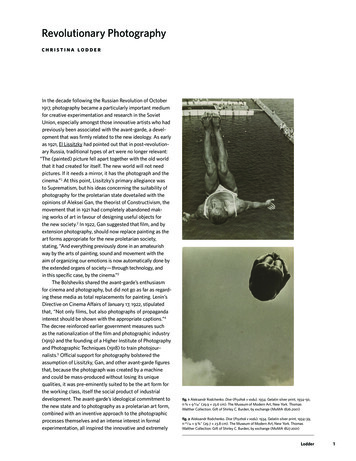
Transcription
Revolutionary PhotographyChristina LodderIn the decade following the Russian Revolution of October1917, photography became a particularly important mediumfor creative experimentation and research in the SovietUnion, especially amongst those innovative artists who hadpreviously been associated with the avant-garde, a development that was firmly related to the new ideology. As earlyas 1921, El Lissitzky had pointed out that in post-revolutionary Russia, traditional types of art were no longer relevant:“The (painted) picture fell apart together with the old worldthat it had created for itself. The new world will not needpictures. If it needs a mirror, it has the photograph and thecinema.”1 At this point, Lissitzky’s primary allegiance wasto Suprematism, but his ideas concerning the suitability ofphotography for the proletarian state dovetailed with theopinions of Aleksei Gan, the theorist of Constructivism, themovement that in 1921 had completely abandoned making works of art in favour of designing useful objects forthe new society.2 In 1922, Gan suggested that film, and byextension photography, should now replace painting as theart forms appropriate for the new proletarian society,stating, “And everything previously done in an amateurishway by the arts of painting, sound and movement with theaim of organ izing our emotions is now automatically done bythe extended organs of society — through technology, andin this specific case, by the cinema.”3The Bolsheviks shared the avant-garde’s enthusiasmfor cinema and photography, but did not go as far as regarding these media as total replacements for painting. Lenin’sDirective on Cinema Affairs of January 17, 1922, stipulatedthat, “Not only films, but also photographs of propagandainterest should be shown with the appropriate captions.”4The decree reinforced earlier government measures suchas the nationalization of the film and photographic industry(1919) and the founding of a Higher Institute of Photographyand Photographic Techniques (1918) to train photojournalists.5 Official support for photography bolstered theassumption of Lissitzky, Gan, and other avant-garde figuresthat, because the photograph was created by a machineand could be mass-produced without losing its uniquequalities, it was pre-eminently suited to be the art form forthe work ing class, itself the social product of industrialdevelopment. The avant-garde’s ideological commitment tothe new state and to photography as a proletarian art form,combined with an inventive approach to the photographicprocesses themselves and an intense interest in formalexperimentation, all inspired the innovative and extremelyfig. 1 Aleksandr Rodchenko. Dive (Pryzhok v vodu). 1934. Gelatin silver print, 1934–50,11 ¾ 9 5/16" (29.9 23.6 cm). The Museum of Modern Art, New York. ThomasWalther Collection. Gift of Shirley C. Burden, by exchange (MoMA 1826.2001)fig. 2 Aleksandr Rodchenko. Dive (Pryzhok v vodu). 1934. Gelatin silver print, 1934–39,11 11/16 9 3/8 " (29.7 23.8 cm). The Museum of Modern Art, New York. ThomasWalther Collection. Gift of Shirley C. Burden, by exchange (MoMA 1827.2001)Lodder1
fig. 3 Aleksandr Rodchenko. Non-Objective Painting no. 80 (Black on Black).1918. Oil on canvas, 32 ¼ 31 ¼" (81.9 79.4 cm). The Museum of Modern Art,New York. Gift of the artist, through Jay Leydafig. 4 Aleksandr Rodchenko. Girl with a Leica (Devushka s Leikoi). 1932–33.Gelatin silver print, 1932–39, 11 13/16 8" (30 20.3 cm). The Museum of Modern Art,New York. Thomas Walther Collection. Gift of Shirley C. Burden, by exchange(MoMA 1828.2001)powerful images produced by Soviet photographers duringthe 1920s and 1930s.The avant-garde figures who now embraced photography did not approach the medium as professionally trainedphotographers, but as artists who wanted to probe itspotential in the same way that they had previously investigated painting and sculpture. Having experimented withabstraction and discarded traditional concepts of art, theywere now intent on exploring the means of manipulatingmaterial as well as the nature of the material itself — whether that was paint, canvas, metal sheets, or camera film andphotographic paper — so that they could exploit the waycolor and form, tone and texture, line and volume, solid andvoid could all convey subliminal messages to the viewer.In rejecting established methods, traditional approaches,narrative, and recognizable subject matter, these artists naturally treated the camera as an instrument to beexplored for its own possibilities as well as for its potentialto convey ideas. Their approach to the photographic process — not just the selection and construction of the imagebut also the way the camera was used in terms of lenses,apertures, and exposures — was subject to experimentation,just as the final print was regarded as a forum for furthermanipulation. These artists were geared toward innovation, and both this attitude towards the creative act and thematerials that were involved were fundamental to the waythat they approached photography.Aleksandr Rodchenko epitomizes this approach. Hetook his first photograph in 1924, adapting to photographymany of the devices and practices that he had developed inhis abstract paintings, three-dimensional constructions, collages, and photomontages. He had often worked in series,producing numerous canvases devoted to one motif, such asthe line. Similarly, he used the camera to create a sequenceof photographs devoted to a single subject, exploring it fromdifferent angles (as in the Dive [Pryzhok v vodu] images of1934; figs. 1 and 2)6 and sometimes in different situations,light, and weather conditions. He tended to treat the components of a photograph as if they were abstract elementsto be arranged at will on a flat canvas. Likewise, Rodchenko’suse of light to intensify relationships between forms insculptures as well as his play with textures in paintings suchas Non-Objective Painting no. 80 (Black on Black) (1918; fig.3) are equally evident in his photographs, such as Girl witha Leica (Devushka s Leikoi) (1932–33; fig. 4).7 The tactic ofemploying oblique, high, and low angles in his photographs(as in the Dive pictures) reflects the diagonal arrangementsof some of his paintings, while his collapsing of the spaceand flattening of the objects also makes the compositionalprocess closer to that utilized in painting.Lodder2
fig. 5 Aleksandr Rodchenko. Spatial Construction, no. 12. (Prostranstvennaiakonstruktsiia, no. 12). c. 1920. Plywood, partly painted with aluminum paint and wire,24 33 18 ½" (61 83.7 47 cm). The Museum of Modern Art, New York.Acquisition made possible through the extraordinary efforts of George and ZinaidaCostakis, and through the Nate B. and Frances Spingold, Matthew H. and EmaFutter, and Enid A. Haupt Fundsfig. 6 Aleksandr Rodchenko. Photomontage illustration in Vladimir Mayakovsky.Pro eto. Ei i mne (About this. To her and to me). Moscow: Gosudarstvennoe, 1923.The Museum of Modern Art, New York. Gift of The Judith Rothschild FoundationRodchenko’s skill in manipulating space in Girl with aLeica, the Dive pictures, and other photographs probablybenefitted from his work with sculpture, such as his seriesof hanging constructions of 1920, which he had createdby cutting concentric rings of a single shape out of a sheetof plywood and then rotating the resulting forms in spaceto create a three-dimensional entity (fig. 5). His inventiveness in orchestrating space may also have been stimulatedby his work with photomontage, for which he selectedand removed photographic fragments from their originalcontexts and recombined them in a creative play with pictorial space, scale, and viewpoint, as in his illustrations forVladimir Mayakovsky’s poem Pro eto. Ei i mne (About this.To her and to me) of 1923 (fig. 6), where he created afluid space, disregarding gravity, and distorting the proportions and scales of observable reality.Rodchenko’s use of unusual angles distorted spatialrelations and made his subjects difficult to read, compellingthe viewer to engage at length with the image. In one Divepicture (see fig. 2), he shot the diver from below against thesky, flattening the space and dramatically foreshortening thefigure, reducing it to a circular shape placed asymmetricallyin what is an essentially abstract composition. It is difficultto read the image and decipher the diver’s physical andspatial orientation. For the literary theorist Viktor Shklovsky,this process of defamiliarization (ostranenie) was integralto the aesthetic process of creation and viewing. Shklovskywrote, “The technique of art is to make objects ‘unfamiliar,’ tomake forms difficult, to increase the difficulty and length ofperception, because the process of perception is an aestheticend in itself and must be prolonged.”8 In the enigmatic Girlwith a Leica, Rodchenko employed shadows to obscure thewoman’s face and angles to distort the spatial relationshipbetween the objects in the photograph and between thephotograph and the viewer. In other images, such as thoseof machines, he often focused on one small part or fragmentof the whole.Before this, the practical and theoretical basis for thesecompositional devices had been developed by Dziga Vertovwhile shooting his Kino-Pravda (Cinema-Truth) newsreels.Vertov took great care over the composition of each frame,which is evident in an untitled photograph of around 1927–28(which may have been actually taken by his brother andcameraman Mikhail Kaufman) (fig. 7). Here the low angleemphasizes the upward thrust of the factory chimney, andthe electricity cables and pylon evoke the progress of industrialization, which held the promise of a socialist future. In1923, Vertov had emphasized the camera’s capacity to generate new types of images: “I, the machine, show you the worldas only I can see it. I emancipate myself . . . from humanimmobility. I am in constant motion. . . . My path leads to afresh perception of the world.”9 Rodchenko was clearly awareof Vertov’s ideas, because he had produced the intertitlesfor the thirteenth issue of Kino-Pravda, in 1922, and both menwere associated with the avant-garde journal Lef.10 Moreover,Lodder3
we know that Rodchenko frequently used cinematic 35mmfilm, which he would have acquired through his friendshipwith Vertov, Sergei Eisenstein, or the filmmaker Esfir Shub(the wife of his fellow Constructivist Aleksei Gan). These filmcontacts were especially important during the 1920s whenRodchenko did not have access to the photographic laboratories of the big publishing houses and had to develop his filmin the small darkroom that he built in his apartment.11 Otheravant-garde photographers were in exactly the same position.Sergei Senkin transformed his room in a communal flat intoa darkroom at night, while Boris Ignatovich, who had no permanent address, devised a portable darkroom.12Rodchenko concentrated on manipulating the camerain relation to a particular subject prior to taking a photograph.In 1927, he was accused of formalism13 and “limiting photography’s aims to those that once belonged to painting.”14 Inresponse, he formulated his ideas concerning photography,emphasizing his use of the worm’s- and bird’s-eye views inhis quest to educate the eye of Soviet man.15 Many of hissubsequent shots featured an explicitly political subject, asin Demonstration (1932; fig. 8), or sports parades or individualsportsmen, whose prowess projected the ideal of the newSoviet man. The Bolsheviks considered that sporting success and physical perfection demonstrated the triumph ofthe revolution, the efficacy of socialism, and the achievements of the Soviet state.In contrast to Rodchenko, Lissitzky was more concerned with working with the photographs once he hadtaken them, an approach that corresponds to what heseems to have understood as fotopis’. Although the term isoften translated as “photography,” it can also be renderedas “painting with photographs” or “photographic painting,”16 which seems to be the meaning suggested here byLissitzky’s statement:The language of photography is not the language ofpainting, and photography possesses properties that are notavailable to painting. These properties reside in the photographic material itself and it is essential for us to develop themin order to make photography truly into an art, into fotopis’.17In a series of photographic works, Lissitzky did preciselythis, exploiting the properties of the “photographic material itself” and building up his images from a “truly virtuosofig. 7 Dziga Vertov. Untitled. 1927–28. Gelatin silver print, 1927–32, 5 ¼ 3 ½"(13.4 8.9 cm). The Museum of Modern Art, New York. Thomas Walther Collection.Abbott-Levy Collection funds, by exchange (MoMA 1894.2001)fig. 8 Aleksandr Rodchenko. Demonstration. 1932. Gelatin silver print, 1932–35,11 ⅝ 9" (29.6 22.8 cm). The Museum of Modern Art, New York. Thomas WaltherCollection. Gift of Shirley C. Burden, by exchange (MoMA 1825.2001)Lodder4
fig. 9 El Lissitzky (Lazar Markovich Lissitzky). Kurt Schwitters. 1924. Gelatin silver print,4 ¼ 3 ⅞" (10.8 9.8 cm). The Museum of Modern Art, New York. Thomas WaltherCollection. Gift of Shirley C. Burden, by exchange (MoMA 1763.2001). 2014 ArtistsRights Society (ARS), New York/VG Bild-Kunst, Bonndeployment of various darkroom techniques, often inunprecedented combinations, including double printing,sandwiched negatives, the use of photogram elementsand the creation of multiple generations of prints.”18 Hismontage portrait of Kurt Schwitters (fig. 9) demonstratesthis approach. The basic structure combines two imagesof Schwitters’s face at different scales.19 One showsSchwitters against the word “Merz” (signifying the concept, as well as his journal). His mouth is shown in variouspositions, suggesting that he had been talking during thephotograph’s intentionally long exposure. The additionof the parrot over the mouth evokes the notion of irrationalverbal utterances, which were integral to Dada performances. The other image contains rectangular elementsand a fragment from the cover of the “nasci” issue of thejournal Merz (1924), on which the two artists collaboratedand in which Lissitzky emphatically rejected his previousemphasis on the machine and instead stressed the closerelationship between nature and science, the organic andthe technical.20 The resulting portrait of Schwitters captureshis connection with Dada while alluding to his brief partnership with Lissitzky and their shared ideas.The same aspiration to convey an aesthetic idea whileusing similar photographic methods and means underliesthe composition inscribed and titled N 2ATUR T2ECHNIK K2UNST -1 i (1924; fig. 10), which Lissitzky undoubtedly made around the same time. The image combinesseveral elements, including a shot looking up through theframework of an engineering structure, probably the EiffelTower.21 This fuses with a photogram of two leaves (chestnutand poplar) and the rectangular construction of a LissitzkyProun. The overlays provide a central pivot (as well as asymbolic fusion of technology and nature), around whichthe composition seems to turn, just like one of Lissitzky’sProun paintings, which he regarded as links between painting and architecture and which he often suggested couldbe viewed from all sides. The overall effect suggests growthand reflects Lissitzky’s definition of nasci on the cover of thejournal as “everything that develops, moves and is generatedthrough its own power.” The use of the square root of minus1 relates to his 1925 article “K. und Pangeometrie” (A. andpangeometry), in which he stated, “A [art] is an inventionof our spirit, a complex whole, combining the rational withthe imaginary, the physical with the mathematical 1 with -1.”22 The mathematical formula may also be connected withLissitzky’s projected book of 1924, provisionally entitled 1 1,an equation that, for the biologist and natural philosopherRaoul Francé, expressed a perfect state of identity, balance,integration, and harmony.23This photograph encapsulates Lissitzky’s concept ofart as a fusion of the biological and the technological. Theimage’s biographical or documentary quality is similar toSelf-Portrait (The Constructor) (1924; fig. 11) as well as to thefig. 10 El Lissitzky (Lazar Markovich Lissitzky). N2ATUR T2ECHNIK K2UNST -1 i.1924. Gelatin silver print with black ink, 6 ¼ 4 7/16" (15.8 11.2 cm). The Museum ofModern Art, New York. Thomas Walther Collection. Gift of Shirley C. Burden, byexchange (MoMA 1762.2001). 2014 Artists Rights Society (ARS), New York/VGBild-Kunst, Bonnfig. 11 El Lissitzky (Lazar Markovich Lissitzky). Self-Portrait (The Constructor). 1924.Gelatin silver print, 5 ½ 3 ½" (13.9 8.9 cm). The Museum of Modern Art, New York.Thomas Walther Collection. Gift of Shirley C. Burden, by exchange (MoMA 1764.2001). 2014 Artists Rights Society (ARS), New York/VG Bild-Kunst, BonnLodder5
photograph of the artist with his set for Sergei Tretyakov’splay Khochu rebenka (I Want a Baby).24 Lissitzky assembledSelf-Portrait (The Constructor) from numerous components,much as he built up the portrait of Schwitters. As a selfportrait, it vividly evokes the artist’s “rationalized artisticpractice,” uniting eye, hand, and compass.25 In contrast tothis formal and aesthetic complexity, the snapshot ofLissitzky working on his set (fig. 12) is a straightforwardphotograph that conveys an emotional and politicalengagement through the artist’s expression as well as theappearance of the word “socialism” (СОЦИАЛИЗ[М]), whichis part of the slogan around the balcony: “A healthy childis the future builder of socialism.”26 Lissitzky may have takenthe photograph using a timer, although it is also possiblethat it was the work of Tretyakov, who was a keen photographer, or Grigorii Miller, who originally owned this particularprint.27 Lissitzky had completed the model (now in the A. A.Bakhrushin Theatre Museum, Moscow) by April 1929,which would seem an appropriate date for the image.28 Theplay controversially confronted the issues of sex, genderroles, and eugenics in the new society.29 Vsevolod Meyerholdintended to stage it as “an illustrated discussion which thespectators would be free to interrupt,” so Lissitzky designeda “laboratory environment,”30 comprising an auditoriumwith a central, multilevel structure, including a transparentstage and moving lights.31 In the photograph, the angleof Lissitzky’s face implies a conversation between the artistand his creation, and his expression suggests tendernessand intimacy. As a document, the image reflects Tretyakov’sargument that “Photography is not just a stenographer; italso explains.”32fig. 13 Roman Karmen. Moscow Illuminations Celebrating the Tenth Anniversary of theRussian Revolution (Moskva noch’iu v oktiabr’skie dni). 1927. Gelatin silver print, 1927–39,9 ⅛ 11 7/16" (23.2 29 cm). The Museum of Modern Art, New York. Thomas WaltherCollection. Abbott-Levy Collection Funds, by exchange (MoMA 1712.2001)fig. 12 Unknown photographer. Untitled (El Lissitzky Working on a Stage Design ofSergei Tretyakov’s play “I Want a Baby” in the Meyerhold Theater). 1929. Gelatin silverprint, 1929–39, 3 ¼ 5 1/16" (8.2 2.8 cm). The Museum of Modern Art, NewYork. Thomas Walther Collection. Gift of Thomas Walther (MoMA 1765.2001)Rodchenko and Lissitzky’s photographic works ofthe 1920s display a great degree of experimentation andinnovation but little political content, although a socialistcommitment is perhaps implicit in their use of the mediumitself. In contrast, Roman Karmen’s 1927 photograph ofMoscow combines a formalist approach with a strong ideological content (fig. 13). Visually, Karmen’s image sharesqualities with Knud Lönberg-Holm’s photograph ofNew York’s Broadway, reproduced in Erich Mendelsohn’s1926 book Amerika: Bilderbuch eines Arkhitekten (America:An architect’s picture book; fig. 14). Both images convey theexcitement of the modern city at night — its vitality,dynamism, and the electrical illuminations that epitomizedthe new pace of everyday life. Both use diagonal compositions as well as long and double exposures in order tocapture words and slogans in electric lights, and the movingheadlights of automobiles. Both photographs were alsoset in the theater districts of the two cities: Broadway in NewYork and the area around the Bolshoi Theater in Moscow.The similarities in composition and approach suggest thatKarmen was aware of the earlier photograph. This is entirelypossible since Lissitzky had enthusiastically reviewedMendelsohn’s book and had even used Lönberg-Holm’sphotograph as the basis for his own photographic collageRecord (Rekord) (1926; fig. 15).33 Karmen could have seen oracquired a copy of Amerika through his publishing contacts,notably with the journal Ogonek (“the small flame”), whichhad been printing his photographs since September 1923.34Karmen’s photograph celebrates ten years ofCommunism — rather than featuring American advertisements (Candy, Central Theater, Dining and Dancing) itfocuses instead on political slogans. “October” (ОКТЯБРЪ)at the top left surmounts the roman numeral X and thedates 1917 and 1927, the word for “years” (ЛЕТ) alongLodder6
fig. 14 Knud Lönberg-Holm. New York: Broadway at Night (New York: Broadway beiNacht). Page 150 in Erich Mendelsohn. Amerika: Bilderbuch eines Architekten (America:An architect’s picture book). Berlin: Rudolf Mosse Buchverlag, 1926. The Museumof Modern Art, New York. The Knud Lönberg-Holm Archive from the MarcDessauce Collectionfig. 15 El Lissitzky. Record (Rekord). 1926. Gelatin silver print, 10 ½ 8 13/16" (26.7 22.4 cm). The Museum of Modern Art, New York. Thomas Walther Collection.Gift of Thomas Walther (MoMA 1766.2001). 2014 Artists Rights Society (ARS),New York/VG Bild-Kunst, Bonnwith the phrase “in the path of Lenin” (ПО ПУТИ ЛЕНИНА), andthe name Marx (МАРКС), which is in smaller letters below.The slogan “The trade union is the school of Communism”(ПРОФСОЮЗ — ШКОЛА КОММУНИЗМА) is just visible beneaththe dome of the building. Karmen made at least two photographs of these revolutionary illuminations, since this imageand a companion piece, of the same subject from a slightlydifferent angle, were both reproduced under the title Moscowat Night during the Celebrations Marking the Tenth Anniversaryof the October Revolution (fig. 16).35 Karmen explained:Night shots of the October illuminations in Moscow. The mostinteresting illuminations of the buildings on Sverdlov Square andSoviet Square were shot on one film. The shots of the illuminations required a long exposure — that is why the headlights of thepassing cars produced lines of light on the film.36Both photographs focus on the illuminated slogansdecorating the Dom Soiuzov (House of Unions), on whatis today the corner of Bolshaia Dmitrovka and Okhotnyi Riad(then called Prospekt Marksa or Marx Avenue). Whereasthe companion piece was clearly taken from the other sideof Theater Square (then Sverdlov Square), from a vantagepoint on Teatral’nyi Proezd looking towards OkhotnyiRiad, the Walther Collection photograph combines severalexposures of various illuminated slogans, including thosefig. 16 Spread from Novyi lef, no. 10 (1927). The Museum of Modern Art, New York.Jan Tschichold Collection. Gift of Philip Johnson. Left: Roman Karmen. Two workstitled Moscow at Night during the Celebrations Marking the Tenth Anniversary of theOctober Revolution. 1927Lodder7
on Tver Square (then Soviet Square). The House of Unionswas politically important. Formerly the House of Nobles(now the headquarters of the trade unions), it was wherethe Communist Party held its congresses and where Leninhad lain in state prior to his funeral in 1924. The choice ofbuilding and the prominent role of the illuminated politicalslogans suggest that Karmen may have been consciouslyinstituting a dialogue with the American image. WhileLönberg-Holm’s photograph could be said to capture theenergy of capitalist America, Karmen’s evokes the dynamism of communist Russia.For a Soviet audience, the medium of the illuminationswas also the message; electricity and Bolshevism were intimately connected. It was Lenin who had initiated work onthe plan for the electrification of Russia in February 1920 andcoined the slogan “Communism is Soviet power plus theelectrification of the whole country.”37 Lenin had stressedthe vital role that electricity would play in uniting and industrializing the vast landmass of Russia, transforming everydaylife and bringing both light and political enlightenment tothe masses. Electric lightbulbs even became known as“Ilyich’s lamps.” As the article accompanying the reproduction of Karmen’s photographs emphasized, “Like signposts,the slogans of the tenth Anniversary of October are showingthe way to tomorrow.”38 Karmen’s twin commitment toartistic innovation and communist ideology was central tothis image and to his later documentary films about theSpanish Civil War, Vietnam, and Cuba.fig. 17 Gustav Klutsis. Untitled (Self-Portrait). 1926. Gelatin silver print, 1926–35,3 ½ 2 9/16" (8.9 6.5 cm). The Museum of Modern Art, New York. ThomasWalther Collection. Abbott-Levy Collection funds, by exchange (MoMA 1741.2001). 2014 Artists Rights Society (ARS), New Yorkfig. 18 Georgii Zimin. Untitled (Montage with Self-Portrait and Building). 1926. Gelatinsilver print, 1926–30, 3 11/16 3 ¼" (9.4 8.3 cm). The Museum of Modern Art,New York. Thomas Walther Collection. Gift of Thomas Walther (MoMA 1920.2001)Gustav Klutsis shared Karmen’s profound allegianceto communism and aesthetic innovation. A member of theCommunist Party and a soldier in the Latvian Red RiflesRegiment, Klutsis produced photomontages celebratingLenin’s Plan of Monumental Propaganda (1920), Lenin’s life(1924), and the First Five-Year Plan (1928–32). These demonstrated his dexterity at orchestrating space and form, askill that had been fostered by his Suprematist paintings(1919–20) and abstract constructions (1921). Like Rodchenko,he began to take photographs in 1924, but tended to usethese for his photomontages and poster designs rather thanregarding them as independent works for publication. Anuntitled image from 1926 (fig. 17) is probably an early selfportrait, although it may also have been taken by his wife,Valentina Kulagina.39 It shows Klutsis with his cap on backwards indicating both his allegiance to the working class andhis intention to go outside. He is holding a camera, his eyeto the viewfinder, suggesting an affinity between man andmachine but also making it clear that the camera is subordinate to the artist’s eye.In contrast, Georgii Zimin’s Untitled (Montage withSelf-Portrait and Building) (1926; fig. 18), also known asSelf-Portrait, Railway Tracks and Platform, possesses a widerideological reference. Zimin was trained as a graphic artist,40Lodder8
time, propaganda or agit trains, like the Red Cossack and V.I. Lenin No. 1, traveled behind the front lines, disseminatingthe revolutionary message, distributing posters, and showing newsreels. In the 1920s, and especially during the FirstFive-Year Plan, when the Soviet regime was concerned withdeveloping heavy industry and modernizing the country’seconomic infrastructure, the development of transport andthe extension of the railway network was considered crucial.Trains operated as practical links between Moscow and theprovinces, carrying materials, goods, and people to andfrom the newly emerging industrial centers. In this context,trains became symbolic of the revolutionary struggle andthe dynamic qualities of Soviet construction. They epitomized the regime’s aspiration to unite the country, abolishthe divide between the cities and the countryside, andestablish socialism.Zimin’s photograph clearly relates to these ideas.The buildings and platform indicate that the station is nota terminus but is on one of the main railway lines, linking the center and the periphery of the country, implyinga continuous flow of traffic and journeys. Moreover, theyoung man is wearing a worker’s cap, and his smiling facefig. 19 Lyubov Popova. The Traveler. 1915. Oil on canvas, 56 41 ½" (142.2 105.4 cm).Norton Simon Art Foundation, Pasadena, Calif. 2014 Norton Simon Art Foundationand his interest in light and movement became manifest inhis photographs of dancers, while his photograms of the1920s consist of prosaic items like screws, scissors, or pliers, organized as autonomous shapes on the paper.41 Thisabstract approach to real objects is reflected in this image,which compositionally combines a circular and pyramidalform, while the fusion of the head, the image of a stationplatform, and the railway tracks going off into the distanceevokes the notion of a journey or memory of a journey.Trains were redolent of the modern age, and the ItalianFuturists’ enthusiasm for the subject had found creativeresponses in Russia with Natalia Goncharova’s Airplane overTrain, Kazimir Malevich’s lithograph Simultaneous Death inan Airplane and at the Railway, and Ivan Kliun’s constructedrelief, Landscape Rushing By. All were produced in 1913 andrefer to new ideas of time and space by combining objectsfrom different spatial contexts within a single image. LyubovPopova explored a more subjective experience of train travelin two paintings entitled The Traveler, both of 1915, whichfuse figures with elements of trains and railway tracks, oneof which (fig. 19) Zimin may have seen at her posthumousexhibition in Moscow in 1924.42After the Revolution, trains acquired enormousideological and strategic importance. During the civil war(1918–20) they played a vital role in moving soldiers andarmaments rapidly to where they were needed. At the samefig. 20 Semyon Fridlyand. In the Gallery (GUM, State Department Store, Moscow)(Auf der Galerie [GUM, Staatliches Kaufhaus, Moskau]). 1927. Gelatin silver print,1930–37, 8 9/16 6 ⅝" (21.7 16.8 cm). The Museum o
photography for the proletarian state dovetailed with the opinions of Aleksei Gan, the theorist of Constructivism, the movement that in 1921 had completely abandoned mak-ing works of art in favour of designing useful objects for the new society.2 In 1922, Gan suggested that film, and by extension photography

